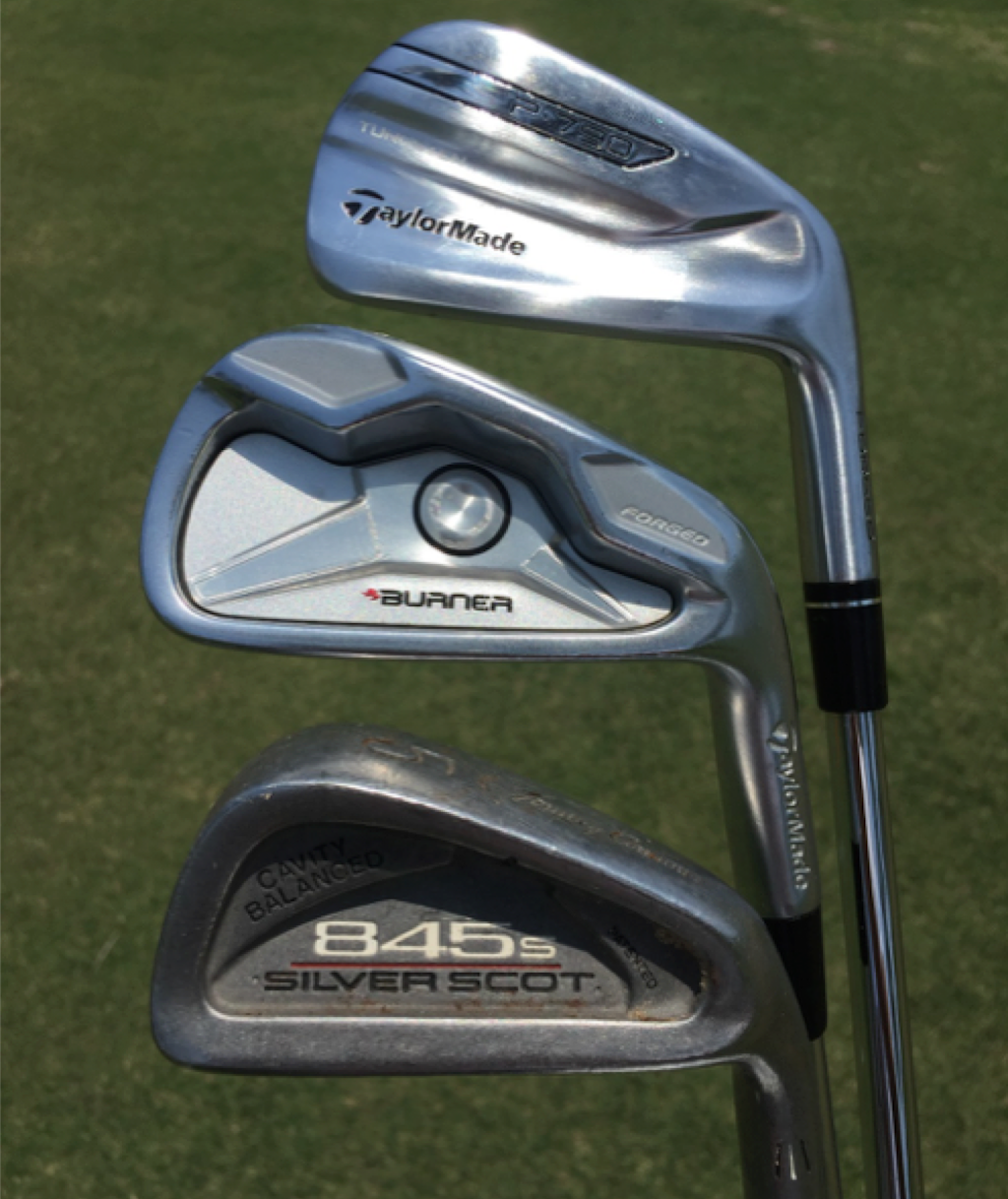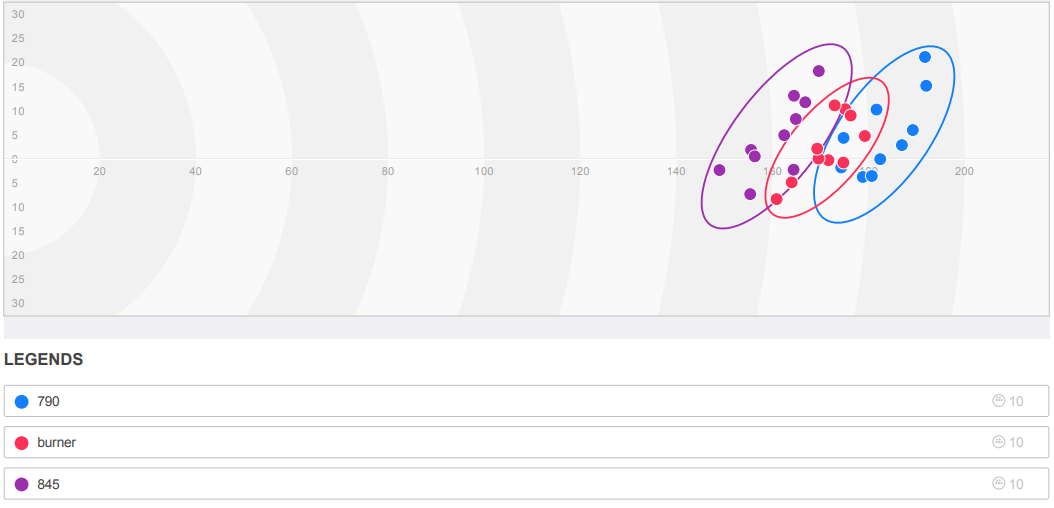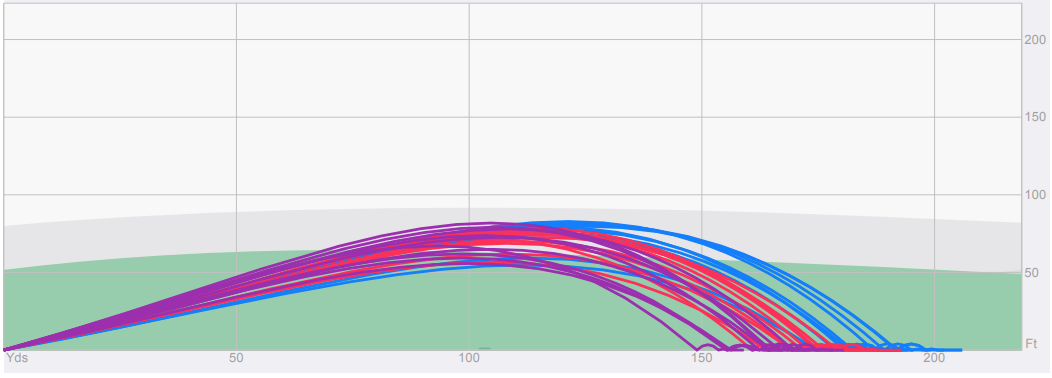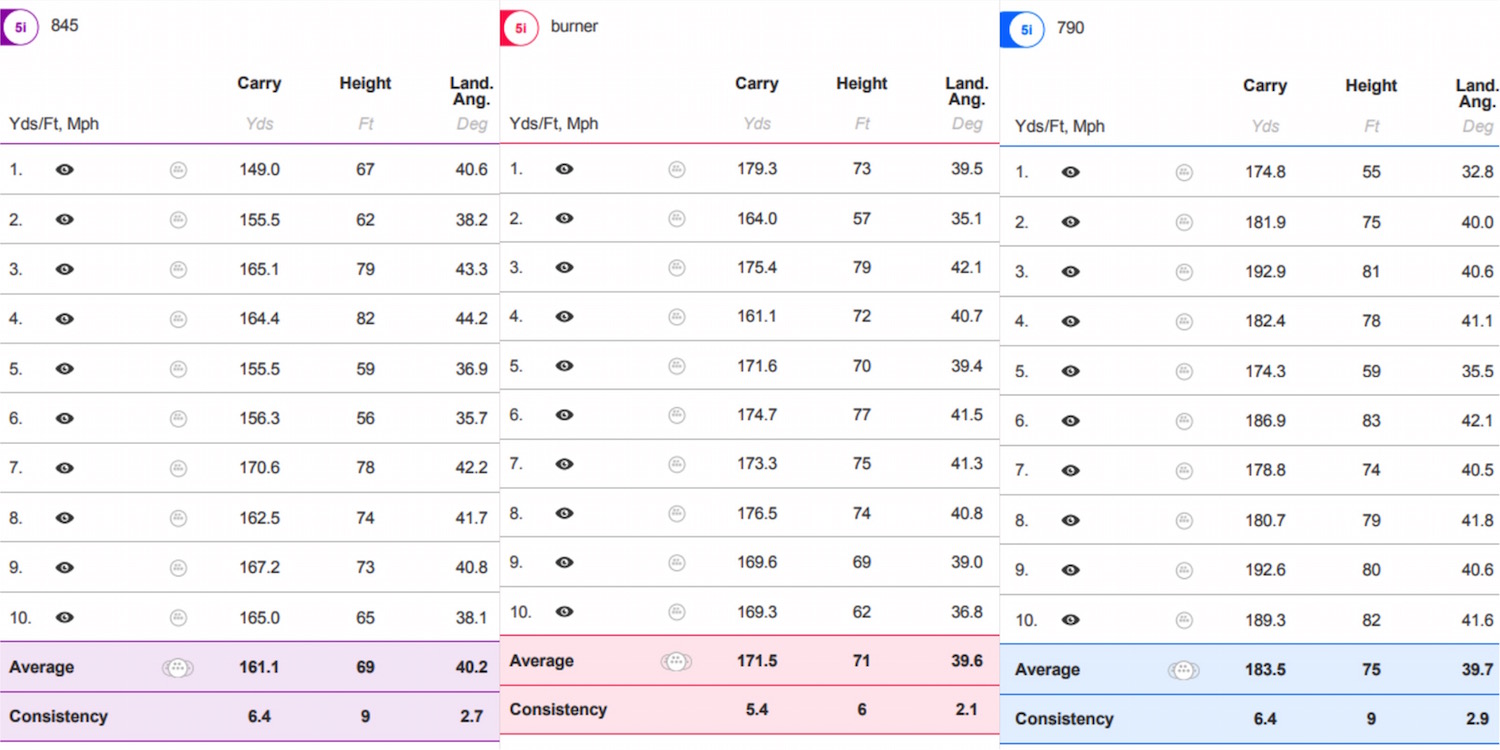Instruction
Should you get new clubs or lessons for quick improvement? Here’s some data…
So I think I have solved the age old question: “do you need new clubs or lessons?” And I have data to back up my suggestions!
First, let’s look at the clubs I am using for this article.

You will see that I used an old Tommy Armour 845 Silver Scot, a forged TaylorMade Burner Forged iron from 2009-2010, and my current P790 from TaylorMade. Of course, we know that the lofts are different between these clubs, and there’s been years of engineering enhancements; we know it’s not an apples to apples comparison, and that’s the point! We are only looking at overall performance to see if we can get away with using older equipment for an extended period of time, or do we need to get rid of them and take lessons? How old is too old?
The Data
Dispersion

Trajectory

TrackMan data
From a dispersion standpoint, the P790 and the Burner have a tighter clustering. Obviously, the older club had the biggest miss pattern since it has the least amount of forgiveness. Therefore, I would say that the older model necessitates upgrade, but not necessarily the Burner.
As we look at the distances, we can see that there are huge differences in the three clubs: 161.1, 171.5, and 183.5 yards. Now from a club vs. lesson standpoint, if distance is a real issue in your game, then I would suggest changing since there is 20 yards difference between the old and the newest club. If not, then you can stick with your old bats and use the extra money to buy a few lessons, as long as your dispersion isn’t totally off.
The final thing I would look at is the height and landing angle of the clubs, and you can see that the last two clubs hit the ball about the same height and have basically the same landing angle into the green. But as we could guess, the older club is not even close.
Conclusion: If your clubs are more than 10 years old, I would suggest an upgrade from a technology standpoint. However, if your clubs have the somewhat newer technology that hits the ball higher with less loft, then you are safe…for now. I would say that unless there’s a serious issue with your clubs (not fit properly, dispersion is terrible, etc) then you should take lessons. To the guys with completely outdated sticks, I would suggest buying newer technology asap. And obviously, if your grooves are completely worn, it’s time to upgrade!!
- LIKE156
- LEGIT18
- WOW2
- LOL2
- IDHT2
- FLOP7
- OB2
- SHANK43
Instruction
Clement: Laid-off or perfect fade? Across-the-line or perfect draw?

Some call the image on the left laid off, but if you are hitting a fade, this could be a perfect backswing for it! Same for across the line for a draw! Stop racking your brain with perceived mistakes and simply match backswing to shot shape!
- LIKE0
- LEGIT0
- WOW0
- LOL0
- IDHT0
- FLOP0
- OB0
- SHANK0
Instruction
The Wedge Guy: The easiest-to-learn golf basic

My golf learning began with this simple fact – if you don’t have a fundamentally sound hold on the golf club, it is practically impossible for your body to execute a fundamentally sound golf swing. I’m still a big believer that the golf swing is much easier to execute if you begin with the proper hold on the club.
As you might imagine, I come into contact with hundreds of golfers of all skill levels. And it is very rare to see a good player with a bad hold on the golf club. There are some exceptions, for sure, but they are very few and very far between, and they typically have beat so many balls with their poor grip that they’ve found a way to work around it.
The reality of biophysics is that the body moves only in certain ways – and the particulars of the way you hold the golf club can totally prevent a sound swing motion that allows the club to release properly through the impact zone. The wonderful thing is that anyone can learn how to put a fundamentally sound hold on the golf club, and you can practice it anywhere your hands are not otherwise engaged, like watching TV or just sitting and relaxing.
Whether you prefer an overlap, interlock or full-finger (not baseball!) grip on the club, the same fundamentals apply. Here are the major grip faults I see most often, in the order of the frequency:
Mis-aligned hands
By this I mean that the palms of the two hands are not parallel to each other. Too many golfers have a weak left hand and strong right, or vice versa. The easiest way to learn how to hold the club with your palms aligned properly is to grip a plain wooden ruler or yardstick. It forces the hands to align properly and shows you how that feels. If you grip and re-grip a yardstick several times, then grip a club, you’ll see that the learning curve is almost immediate.
The position of the grip in the upper/left hand
I also observe many golfers who have the butt of the grip too far into the heel pad of the upper hand (the left hand for right-handed players). It’s amazing how much easier it is to release the club through the ball if even 1/4-1/2″ of the butt is beyond the left heel pad. Try this yourself to see what I mean. Swing the club freely with just your left hand and notice the difference in its release from when you hold it at the end of the grip, versus gripping down even a half inch.
To help you really understand how this works, go to the range and hit shots with your five-iron gripped down a full inch to make the club the same length as your seven-iron. You will probably see an amazing shot shape difference, and likely not see as much distance loss as you would expect.
Too much lower (right) hand on the club
It seems like almost all golfers of 8-10 handicap or higher have the club too far into the palm of the lower hand, because that feels “good” if you are trying to control the path of the clubhead to the ball. But the golf swing is not an effort to hit at the ball – it is a swing of the club. The proper hold on the club has the grip underneath the pad at the base of the fingers. This will likely feel “weak” to you — like you cannot control the club like that. EXACTLY. You should not be trying to control the club with your lower/master hand.
Gripping too tightly
Nearly all golfers hold the club too tightly, which tenses up the forearms and prevents a proper release of the club through impact. In order for the club to move back and through properly, you must feel that the club is controlled by the last three fingers of the upper hand, and the middle two fingers of the lower hand. If you engage your thumbs and forefingers in “holding” the club, the result will almost always be a grip that is too tight. Try this for yourself. Hold the club in your upper hand only, and squeeze firmly with just the last three fingers, with the forefinger and thumb off the club entirely. You have good control, but your forearms are not tense. Then begin to squeeze down with your thumb and forefinger and observe the tensing of the entire forearm. This is the way we are made, so the key to preventing tenseness in the arms is to hold the club very lightly with the “pinchers” — the thumbs and forefingers.
So, those are what I believe are the four fundamentals of a good grip. Anyone can learn them in their home or office very quickly. There is no easier way to improve your ball striking consistency and add distance than giving more attention to the way you hold the golf club.
More from the Wedge Guy
- The Wedge Guy: Golf mastery begins with your wedge game
- The Wedge Guy: Why golf is 20 times harder than brain surgery
- The Wedge Guy: Musings on the golf ball rollback
- LIKE86
- LEGIT13
- WOW6
- LOL1
- IDHT0
- FLOP4
- OB1
- SHANK8
Instruction
Clement: Stop ripping off your swing with this drill!

Not the dreaded headcover under the armpit drill! As if your body is defective and can’t function by itself! Have you seen how incredible the human machine is with all the incredible feats of agility all kinds of athletes are accomplishing? You think your body is so defective (the good Lord is laughing his head off at you) that it needs a headcover tucked under the armpit so you can swing like T-Rex?
- LIKE0
- LEGIT2
- WOW2
- LOL0
- IDHT0
- FLOP0
- OB0
- SHANK2
-

 19th Hole2 weeks ago
19th Hole2 weeks agoDave Portnoy places monstrous outright bet for the 2024 Masters
-

 19th Hole3 days ago
19th Hole3 days agoJustin Thomas on the equipment choice of Scottie Scheffler that he thinks is ‘weird’
-

 19th Hole2 weeks ago
19th Hole2 weeks agoTiger Woods arrives at 2024 Masters equipped with a putter that may surprise you
-

 19th Hole3 days ago
19th Hole3 days ago‘Absolutely crazy’ – Major champ lays into Patrick Cantlay over his decision on final hole of RBC Heritage
-

 19th Hole3 weeks ago
19th Hole3 weeks agoReport: Tiger Woods has ‘eliminated sex’ in preparation for the 2024 Masters
-

 19th Hole1 week ago
19th Hole1 week agoTwo star names reportedly blanked Jon Rahm all week at the Masters
-

 19th Hole1 week ago
19th Hole1 week agoReport: LIV Golf identifies latest star name they hope to sign to breakaway tour
-

 19th Hole1 week ago
19th Hole1 week agoNeal Shipley presser ends in awkward fashion after reporter claims Tiger handed him note on 8th fairway















Hayden
Apr 27, 2019 at 5:34 am
Thanks for this article.
I actually have a set of Tommy Armour Golden Scots from the mid 1990’s! I couldn’t afford the 845’s… Interestly, 20 years later, with ball technology & better swing insight, I’m hitting the clubs the same distance & slightly further (5-10yds) – and I’ve gone from mid 20’s to mid 40’s in age.
But the grooves are worn & offer no stopping power. My swing still needs work, so because it’s cheaper to get lessons than buy a new set of clubs, that’s what I’m doing with my $$. Good to know that once I save enough money, a new set will make a big difference. Getting them fitted will be vital too.
Cheers!
Gerald Teigrob
Jul 4, 2018 at 11:57 am
I still have a good part of my Adams A7 irons but are gradually moving more to Redline irons and have replaced my irons with the Cobra Bio Cell in both stiff graphite and stiff steel. I left some clubs of mine behind to pick those up and I nearly have a set of Cobra Baffler XLs. Not everyone has the luxury of upgrading like I do with our golf course but as long as you leave some clubs behind, you, it appears to be the honor system…these are demo irons. So with that in mind, I won’t need to upgrade for a while! I’m glad to have both stiff graphite and steel in the Bio Cell irons!
geohogan
Jul 7, 2018 at 9:44 am
Unless the shafts are identical in all of the irons tested, then you can bet your testing difference in shafts more than iron heads.
Tom
Jul 2, 2018 at 11:21 am
Let’s talk about shafts.
Just how much clubhead speed/distance is gained for every, say 10 grams, less shaft weight? Maybe 2-3 yds with a 7 iron?
How much distance/ dispersion difference is there between stiff and flexible shaft tips? Maybe 2-3 yds distance, 5-10 yds dispersion difference with the same 7 iron?
Tom
Jul 2, 2018 at 11:27 am
On shaft weight, I way overstated the distance gained for 10 grams lighter shaft .5 to .7 yards is probably closer to reality.
Dr Tee
Jul 2, 2018 at 8:42 am
Do both. Lessons and new clubs are not mutually exclusive. No new club will correct a bad swing path
Gerald Teigrob
Jul 4, 2018 at 12:00 pm
I have managed lessons at GolfTec, so now I need to apply those principles to my own game with newer clubs! Fortunately, I can go back to previous lessons and see what I did online and what the purpose of that lesson was! Lessons and club fitting can go along well…that way you get to see how well your playing with your current irons is in relation to newer irons!
Lane Holt
Jul 2, 2018 at 8:25 am
This is not a serious test / comparison. Their is nothing in a iron head that will make a ball go further other than it’s loft. If folks ever learn that the shaft is the engine and it ‘s performance is many times more iimportant that the head these Mfgts. will not be able to charge their ridiculous prices .
When are we going to learn ? Iron heads ( faces ) have not changed in 50 years. How many tournament did Sam Snead, Ben Hogan, Byron Nelson win ? The ball only stays on the face 1/20 th of a millisecond. Think about that and tell me what difference the head makes?
Now- could a shaft with a flexible tip make a difference ? You betcha it does!
Thomas A
Jul 2, 2018 at 12:10 pm
A true science denier!
JThunder
Jul 1, 2018 at 2:07 am
The distance question isn’t answered at all in this article; from what I can gather, the clubs were 5 irons? So, compare the 845s 4 iron to the 790 5 iron – loft and length are likely closer. If the dispersion and trajectory are better on the 790, then it is an improvement. Also, compare the 790 PW and 845s 9 iron – again, probably similar loft and length. If the 790 dispersion is better, then you’ve gained something. If not, then really all you’ve done is re-number the clubs, which is meaningless.
For dispersion, I would double the number of balls. Either it will close the gap – make them more similar, or if the older clubs is less forgiving / harder to hit, the gap will widen.
NB Solets
Jul 1, 2018 at 10:47 am
Agreed. If the test did not reasonably match loft and length, then the test results are fairly meaningless. Most of these “tests” get this wrong.
Geohogan
Jul 2, 2018 at 1:49 pm
and use identical shafts both length and cpm. Then test all irons with the identical high end shaft.
If they did that and new irons proved not to be significantly better than the old, would golfers stop buying new irons?
Johnny Penso
Jul 1, 2018 at 7:25 pm
There is a 4.5 degree difference in lofts between the 7 irons of the 845’s and the 790’s. That’s a whole club plus a bit. But your point is well taken. You’d think that someone in the golf business would now that you test dispersion at fixed distances not based on the arbitrary number on the bottom of the club.
Tony
Jun 30, 2018 at 8:22 pm
845’s were my first irons. Shot my lowest round ever, 74, with those clubs.
Dan
Jun 30, 2018 at 7:02 pm
readinf this I’m not thrilled I just dropped $1300 replacing my old irons
SV
Jun 30, 2018 at 3:42 pm
Maybe it’s my eyesight, but dispersion for the 845s and P790s both distance and left to right appear to be about the same. The Burner has tighter dispersion. Trajectory is definitely better with the newer irons.
If you want to improve find an old blade iron and practice with it. Add a real wooden driver also. It really does make a difference.
K
Jun 30, 2018 at 1:55 pm
Usually far from a quick improvement but Im a BIG believer in the old “true blades are the best teachers”. I know it can be tough for some people coming from GI irons to stick it out and make it work. Though once it clicks in their head how to strike it perfectly they are on a whole new level of lower scores. Everyone is capable of making it work. They might not hit the blades as far due to lofts and club speed at that point they should switch back to the GI clubs when on course and want distance/lower scores. I think everyone that wants to improve should at least get a few (if not a whole set) of decent used bladed irons and start practicing.
Richard Douglas
Jul 1, 2018 at 9:51 am
When I see tennis players practicing with Wilson T-2000 rackets I’ll agree. Until then, practice with what you’ll play.
Johnny Penso
Jul 1, 2018 at 7:30 pm
When I see professional golfers playing with blades I’ll agree…oh wait…